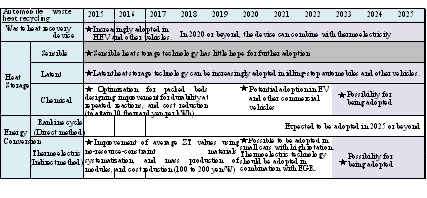Automobile Waste Heat Recycling Technologies: Key Research Findings 2015
Research Outline
- Research period: From March to May 2015
- Research targets: Manufacturers of automobiles, exhausting gas related devices, heat storage materials, thermoelectric power generation elements, universities and other research and development institutions.
- Research methodologies: Face-to-face research by the expert researchers, survey via telephone and e-mail, and literature research.
What are Automobile Waste Heat Recycling Technologies?
The automobile waste heat recycling technologies in this research indicate waste heat recovery, thermal energy storage, and energy conversion technologies. Note that for heat storage technologies, sensible, latent and chemical heat storage technologies are taken up, while for energy conversion technologies, thermoelectric power generation technology which is a direct method and Rankine cycle technology, an indirect method, are pursued in this research.
The research summarizes the trends of domestic and overseas automobile waste heat recycling technologies, extracts the issues and challenges when introducing such technologies for practical use, and analyzes the prospective.
Summary of Research Findings
- As of 2015 Waste Heat Recovery Devices in Practical Use
Waste heat recovery devices have already been introduced in HEVs as of 2015. Whereas in diesel-powered vehicles the device showed limited effects so that further application cannot be expected in that area of automobiles, it is promising in the area of HEVs and other vehicles with more adoptions expected
- Chemical Heat Storage Technology Considered as Promising
Sensible and latent heat storage technologies have contributed in recovering waste heat, but those technologies have limits in stored energy density and in temperature available to recover exhaust heat. In respect of heat storage at higher temperature and higher thermal storage density, chemical heat storage technology is considered to meet expectations. Nevertheless, in spite of several verification tests, the chemical heat storage technology still has some challenges to overcome, including optimization of packed beds designs, improvement for durability at repeated reactions, cost reduction (to attain 10 thousand yen per kWh) and more.
- Thermoelectric Generators Expected to be Adopted in 2023 At the Earliest
Thermoelectric generators have not yet been tested for practical use when it comes to automobiles, but the development is in progress at automakers and other related companies. It is said that a thermoelectric power generation system improves fuel efficiency of an automobile travelling in a city by 3 to 5% by using around 200 to 300 watts of electricity recovered. In order for the thermoelectric generators to be practically introduced to the automobiles, they need to improve thermoelectric efficiency (ZT values) using no-resource-constraint materials, systematize using appropriate elements, and make available for module mass production and for cost reduction.
- Table 1: Timing of Adoption of Automobile Waste Heat Recycling Technologies
